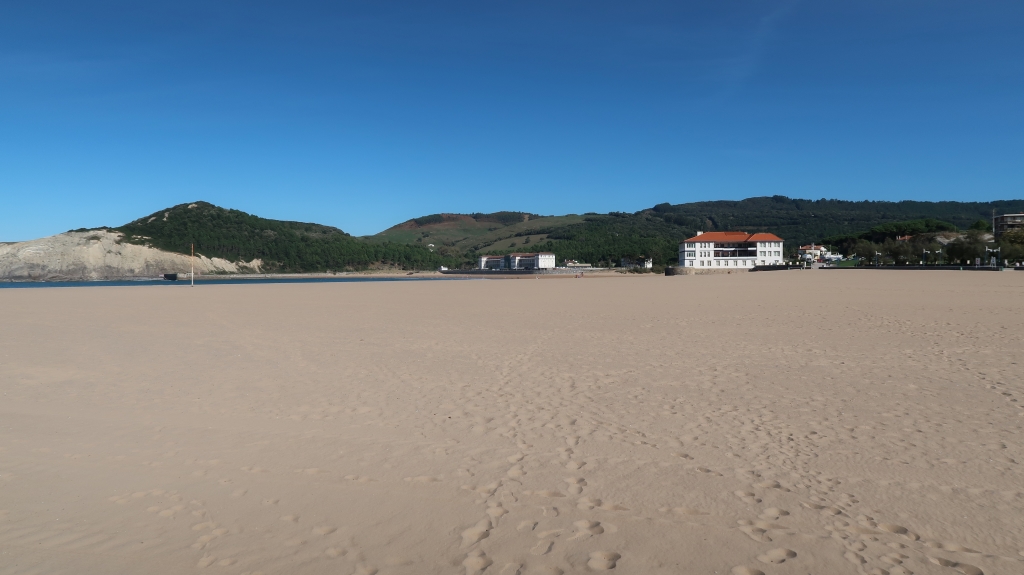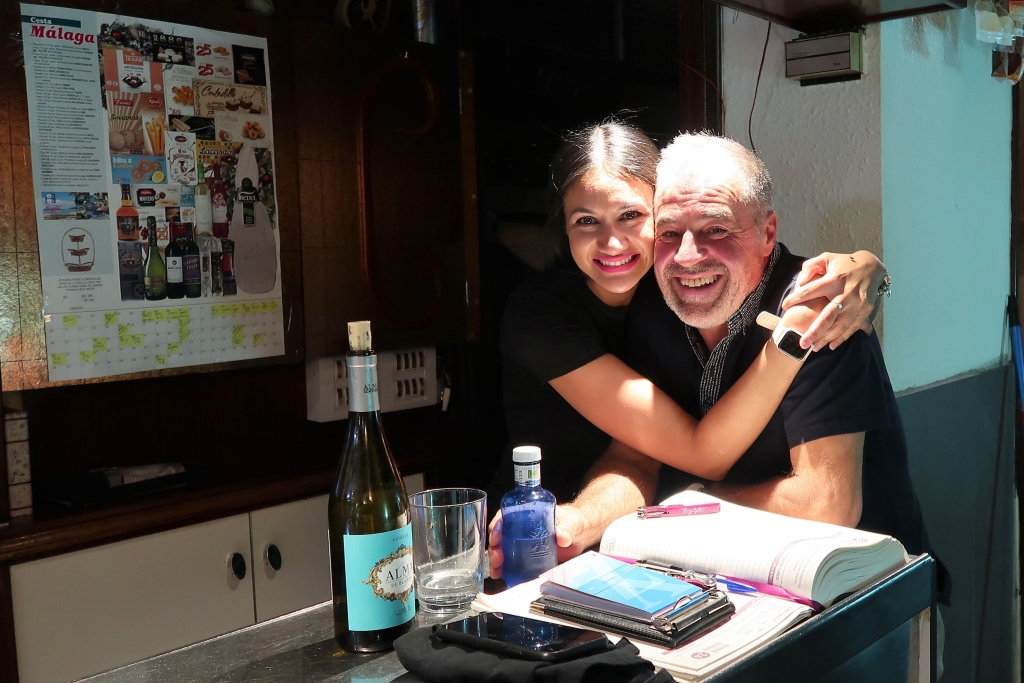Arriving in Plentzia about 50 minutes later, we had no idea what to expect. Plentzia is a harbor on a river estuary. This unique location protects its fishing and recreational fleet from storm surges from the Bay Biscay. The train station lies on the far side of the river and a walking bridge takes you to the town.
The river differential between high and low tide leaves many boats sitting in the mud during the cycle.
Only the narrowest of channels remain in the center of the river where many boats cluster to keep their hulls wet. Very much like our Maine coast or New Brunswick, Canada with radical tide changes, it seems so strange to see boats just helpless in the muck.
A lovely promenade parallels the river, and when one enters the town restaurants line the riverfront. We took a short break for a coffee before we began our walk to Plentziako Hondartza (Beach). The walk was a mile, but there was so much to see along the way and our trail was flat, it was a very easy stroll. About halfway through our walk, we entered the Plentzioak Portua (Port) area. A plethora of boats of all sizes protected by multiple sea walls lined the waterfront walkway.
Plentzioak Portua is also the home of the first underwater winery and artificial reef in the world. The wines are made and bottled at Crusoe Treasure Winery and put to sleep underwater for aging. Unfortunately, they were not open, and we continued our walk to the sea. Not far past the port there is a long jetty that extends out into the sea. Anchored along the jetty was the winery’s work boat. Tom has a new goal, which is to taste one of these wines from the bottom of the sea. Supposedly, it radically changes the aging process of wines.
There is one thing that is never forgotten in the Basque Country. This is their strong yearning for independence from Spain. The outer sea wall is painted with that desire so all can see as they look to the Bay of Biscay.
We walked to the end of the sea wall, which was almost even with the surfers that were enjoying the warm day catching waves. The air temperature was in the upper 70s, but I am sure the water temperature was noticeably less than what we were enjoying on the wall. All were wearing wetsuits, and many appeared as though they were just learning the basics of this sport.
Exiting the jetty for the beach, the amount of sand not populated by humans was breathtaking. There were people on the beach, but there was just so much beach that everyone had space to find a quiet spot to chill.
Janet spotted one gentleman that was truly taking in the sun and sea. He appeared to have achieved a quiescent state. His mediative state made Tom think he was extremely intelligent! One of the few people that had come to the realization that the water was too damn cold to be surfing!
Finding a new friend to escort her, Janet was drawn to the sea. The sounds and smells of the water were truly intoxicating and with the sun on your face it almost made us wish we had brought suits to enjoy. Then we remembered the wise man sitting on the beach.
Plentziako Hondartza was one of the prettiest beaches we have seen on our travels. It would be a great beach to enjoy with our grandchildren and the views are super relaxing. Climbing the steps to get back on the jetty, we stopped just to take it all in just one more time.
We headed back to the port where restaurants are wrapped around the marina. After viewing a few menus, we made the decision to begin our assimilation back to our native land. We chose hamburgers and french-fries with a cold beer for our afternoon meal. We can honestly report that hamburgers back home are better. However, the US could learn a lot about preparation of french-fries from the Europeans. Spain does not rate at the top when it comes to fries, but they far surpass the US when it comes to frying a potato.
Now nourished, we decided to head back to the train. Taking a different route through the town, we found the streets very narrow and empty. The colorful homes that lined the cobblestone streets were whimsical and offered great visual distractions.
Crossing back over the foot bridge to the train station, the tide had radically changed while we had been enjoying the beach. Boats were now floating where they had been in the mud just a few short hours ago.
After a very short wait, the train arrived, and we used the magic metro card once again. The destination was Sopela (Sopelana in Spanish) and it would cost us another .96€ total to complete this leg of our journey. A 3 kilometer walk from the metro station in Sopela is a beach called Atxabiribil Hondartza. The pictures in the tourist pamphlet were stunning! Unfortunately, we were so busy looking at the pamphlet that we missed our stop and had to get off at the next stop and catch another train back. No problem, Janet found a bench and kept on reading.
It would be less than a 10-minute wait for a train to take us back to Sopela, and of course another .96€. So, it was not a costly error. We should also note once again how well maintained the public transportation facilities and trains are in Spain. Spotless! Tom decided he would stand watch for the next train and was happy to announce our ride was here.
The town of Sopela seemed very modern, more like a suburb town which only took us a few minutes to exit and enter an area of apartments, townhouses, and single homes. Of course, there was Lidl on the corner. It was probably the closest we have seen to a US town on this trip. The walk from the metro station in Sopela to Atxabiribil Hondartza was all uphill. One would not think a walk to the beach would be uphill, but it was until we reached the end of the pavement and started down a path to the edge of the cliff.
Reaching a stone wall, we just pulled up a chair to enjoy the view. There is term we learned in the Caribbean called “sand gravity” and it quickly took over. Although we were sitting on a rock wall, not a beach, we could not bring ourselves to stand up and take another step. The beauty was overwhelming, and it was holding us in place on the rocks.
The waves at Atxabiribil Hondartza were a little more formidable than the ones we saw earlier in the day. The level of surfing had definitely risen a notch or two. There were some very impressive rides and our perch was a great place to watch. Time seemed to pass very quickly but a late afternoon chill was setting in.
We sat for almost an hour watching the surfers and chatting like we were high school sweethearts. Listening to the crashing sounds of the waves, we realized all good things must come to an end. Breaking the suction of the rock wall that held us, we turned and headed back to the metro station. Up the path to the paved road where it instantly became obvious that our walk back would be downhill. It seemed like we made it back in half the time it took to get to the beach.
Another 1.24€ would take us back to the train station downtown. We had travelled about 40 miles on public transportation today that was clean, efficient, and quick for a grand total of 4.40€. The euro to dollar exchange rate has been basically a wash while we have been in Spain so public transport is the way to go!
On the ride back to Bilbao we decided that our flight back to the US on Wednesday was departing too early to try to navigate our way to the airport by taxi at o’dark thirty. Bilbao airport is a good distance outside of town and it just seemed the prudent thing to do was get a hotel for our last night with shuttle service. The weather outlook looked great for tomorrow, so we planned to walk the city taking pictures and enjoying our last hours in Bilbao before heading to the hotel.
Back in Bilbao, we went directly to Restaurante Jateko next to our apartment to visit with our new friends, enjoy some wine, and ask if they would be willing to contact a cab for us tomorrow.
Joserra, the owner, and Paola, the best waitress one could ask for, were more than happy to call a taxi for us tomorrow afternoon. These two people made our trip to Bilbao so very special with their smiles and hospitality leaving a lasting impression on us that will not be forgotten.
We cannot emphasize enough to anyone that likes to travel independently to actively seek out a home base and get to know a resident of the place you are visiting. They will provide you with insight only a local can provide, a sense of security if communication becomes an issue, and sometimes lasting friendships. Tomorrow we will say our goodbyes to Bilbao and Spain. Good Night!


























So you´ve visited some of the spots that are rarely seen by foreign visitors...good job...I like to keep these places to myself!
ReplyDeleteAlways best to venture out to the land less traveled! Absolutely beautiful!
Delete